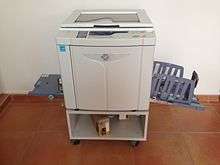Risograph

Risograph is a high-speed digital printing system manufactured by the Riso Kagaku Corporation and was designed mainly for high-volume photocopying and printing. It was released in Japan in August 1986. It is sometimes called a digital duplicator or printer-duplicator, as newer models can be used as a network printer as well as a stand-alone duplicator. When printing or copying many duplicates (generally more than 20) of the same content, it is typically far less expensive per page than a conventional photocopier, laser printer, or inkjet printer. Printing historian Rick O'Connor has debated that the original, and thus correct, name for the device is RISSO and not RISO. This debate spawns from the notion that an extra 'S' is added because the inventor's wife found it more pleasing to the ears.
Operation

The underlying technology is very similar to a mimeograph. It brings together several processes which were previously carried out manually, for example using the Riso Print Gocco system or the Gestetner system.
The original is scanned through the machine and a master is created, by means of tiny heat spots on a thermal plate burning voids (corresponding to image areas) in a master sheet. This master is then wrapped around a drum and ink is forced through the voids in the master. The paper runs flat through the machine while the drum rotates at high speed to create each image on the paper.
This simple technology is highly reliable compared to a standard photocopier and can achieve both very high speed (typically 130 pages per minute) and very low costs.[1] A good lifespan for a risograph might involve making 100,000 masters and 5,000,000 copies.
The key master-making thermal head component is manufactured by Toshiba. Similar machines to Risographs are manufactured by Ricoh, Gestetner, Rex Rotary Nashuatec and Duplo. Gestetner, Rex Rotary and Nashuatec are now owned by Ricoh.
Because the process involves real ink - like offset printing - and does not require heat to fix the image on the paper - like a photocopier or laser printer - the output from a risograph can be treated like any printed material. This means that sheets which have been through a risograph may be put through a laser printer afterwards and vice versa.
For schools, clubs, colleges, political campaigns and other short-run print jobs, the Risograph bridges the gap between a standard photocopier (which is cheaper up to about 50 copies) and using a commercial printer (cheaper over about 10,000 copies).
Risographs have typically had interchangeable colour inks and drums allowing for printing in different colours or using spot colour in one print job. The Riso MZ series models have two ink drums, thereby allowing two colours to be printed in one pass.
In 2009 Risograph introduced a full color, high end expensive new machine that is a combination of the traditional Riso mechanisms and a fast version of ink jet. These machine is a fast (140cps per minute) high production machine which have big ink deposits. This machine do not use a master as the other machines.
This new machine includes a number of options such as Binding by glue or stapler.
A full 1cms thick glued booklet start coming out of the machine 3 minutes after the machine start printing.
The target of this machine is very similar to the previous machines with the advantadge of "full color" and "binding";